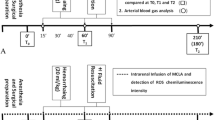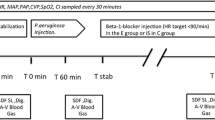Abstract
Objective: To investigate the effect of rhubarb on gastrointestinal blood perfusion in critical illness and hemorrhagic shocked rats.Methods: Clinical Study: Sixty-four septic patients, who suffered from stress ulcer, were treated with rhubarb at a dose of 25 mg/kg. Twenty-five non-septic patients were taken as control. The gastrointestinal perfusion was evaluated by intramural pH (pHi). Animal study: SD rats were anesthetized with intraperitoneal sodium pentobarbital at a dose of 20 mg/kg. Blood-letting were performed in the animals. Blood pressure reduced to 5.32 kPa and maintained for 120 mins. They were resuscitated at the end of shock by reinfusing all of the shed blood. The rats were randomly divided into four groups: Normal control, shock group, therapeutic group (shocked rats were treated with 50 mg/kg rhubarb at the end of shock) and rhubarb group (normal rats were treated with rhubarb). Laser Doppler was applied to estimate the gastrointestinal blood perfusion.Results: Clinical Study: The gastrointestinal pHi in septic patients was much lower than that in the control, whereas rhubarb could obviously elevate gastrointestinal pHi (P < 0.001). In addition, rhubarb also had good effect on gastric hemorrhage caused by stress ulcer. Animal Study: Although the shocked rats were resuscitated completely, their gastrointestinal blood perfusion was much lower than that in the control. Rhubarb could significantly improve the blood perfusion in gastrointestinal mucosa and mesentery (P < 0.01). Furthermore, rhubarb also increase the gastrointestinal perfusion in normal rats.Conclusion: Rhubarb could improve gastrointestinal blood perfusion in critical illness and shocked rats.
Similar content being viewed by others
References
Border JR. Multiple system organ failure. Ann Surg 1992; 216(2):111–116.
Schiessel R, Feil W, Wenzel E. Mechanisms of stress ul-ceration and implications for treatment. Gastroenterol Clin North Am 1990; 19(1): 101–120.
Chen DC, Yang JD, Yang XY, et al. The effects of rhubarb on permeability of intestinal mucosa and blood vessel in shocked rats. Chin Crit Care Med 1997; 9(7): 385–387.
Chen DC, Jing BW. The effects of rhubarb on the protection of gut barrier. Chin Crit Care Med 1994; 6(6):329–331.
American College of Chest Physician/Society of Critical Care Medicine Consensus: Definitions for sepsis and organ failure and guidelines for the use of innovative therapies in sepsis. Crit Care Med 1992; 20(6):864–874.
Chen DC, Jing BW, Yang XY, et al. Therapeutic effects of rhubarb on gastrointestinal failure. Med J Chin PLA 1996;21(1):24–26.
Nakayama SE. Infusion of very hypertonic saline to bled rats: membrane potential and fluid shifts. J Surg Res 1985; 38(2): 180–186.
Bulkley GB. Relationship of blood flow and oxygen consumption to ischemic injury in the canine small intestine. Gastroenterology 1985;89(4): 852–857.
Marshall JC, Christon NV, Meakins JL, et al. The gastrointestinal tract: The undrained abscess of multiple organ failure. Ann Surg 1993;218(2): 111–119.
Fiddiann-Green RG, McGough E, Pittenger G, et al. Predictive value of intramural pH and other risk factors for massive bleeding from stress ulceration. Gastroenterology. 1983;85(3):613–620.
Zhu L, Yang ZC, Li A. Changes and significance of the ability of gastric acid excretion during burn shock in rats. Chin Crit Care Med 1997;9(7): 398–399.
Jiao DH, Chen SX, Zhang GH, et al. Clinical study of the effects of rhubarb on peptic ulcer with hemorrhage. CJITWM 1984;10(10):597–599.
Yu JD, Gong LS. Effects of rhubarb on thromboxane A2 and prostacyclin in circulation blood in healthy people and acute myocardial infarction. Edited by Jiao Dong-hai. JIAO Dong-hai Proceedings. Shanghai: Shanghai Science and Technology Press, 1999:150–152.
Liang ZJ, Liu XC, Jiao DH. Effects of rhubarb on the change of hemorheology in pre- and post-treatment in healthy people. CJITWM 1984;9(9);560–562.
Author information
Authors and Affiliations
Corresponding author
Additional information
Supported by National Natural Scientific Foundation, No. 39570688
Rights and permissions
About this article
Cite this article
Chen, Dc., Yang, Xy., Jiang, Xl. et al. Clinical and Experimental Study of effects of rhubarb on gastrointestinal blood flow perfusion in critical illness. CJIM 7, 2–6 (2001). https://doi.org/10.1007/BF02935096
Received:
Issue Date:
DOI: https://doi.org/10.1007/BF02935096




